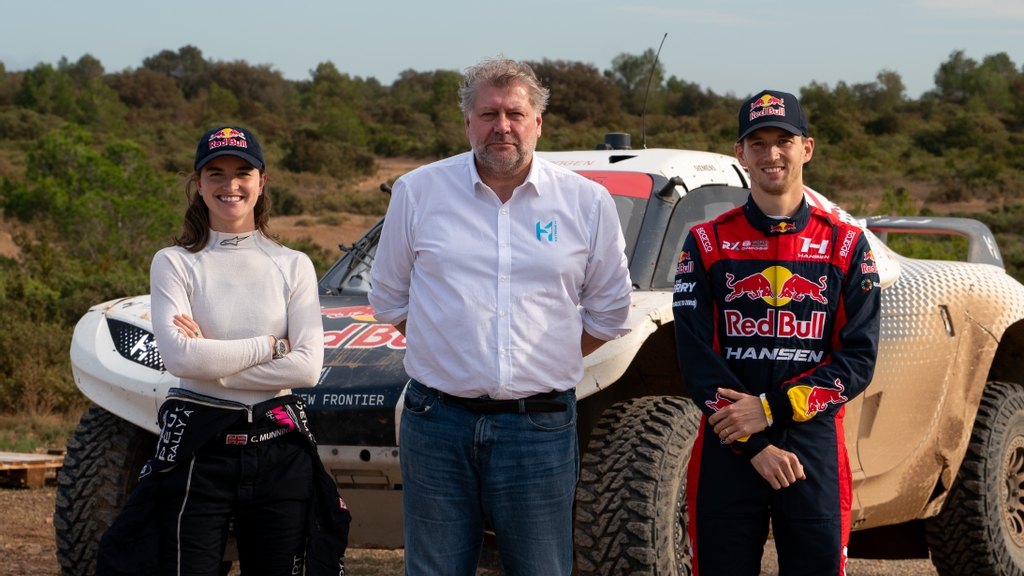How Motorsport Can Accelerate Hydrogen Technologies

We caught up with Mark Grain, Extreme H’s Technical Director, to find out more about the Pioneer’s cutting-edge hydrogen fuel cell technology, showcasing hydrogen’s viability in demanding environments, and why motorsport is a crucial platform for accelerating sustainable energy adoption in motorsport and beyond.
Q: Mark, firstly, what was behind Extreme E's decision to switch to Extreme H?
A: Mark Grain: We chose to transition to Extreme H and focus on hydrogen because it’s essential for a zero-emission future in mobility, energy storage, and beyond. We know a lot more about electric now, thanks to the performance settings of championships like Formula E and Extreme E.
This sporting platform does not currently exist for hydrogen so there was a huge gap to be filled. Extreme H is designed to be a proving ground for hydrogen technology, demonstrating that hydrogen can deliver top-tier performance while also being sustainable.
The exposure to a widespread global audience, and the extreme racing test bed Extreme H enables, which will include high temperatures, sandy, tough terrains, and of course the potential for crashes and impact, will help supercharge R&D learnings in hydrogen, and also crucially demonstrate its safety.
Q: Why is motorsports such a crucial platform for advancing hydrogen fuel cell technology?
A: Mark Grain: Motorsports, especially a pioneering platform like Extreme H, are perfect environments for pushing the limits of hydrogen fuel cell technology. The demands of racing, high power, endurance, and extreme conditions, really challenge fuel cells, enabling us to rapidly improve performance, efficiency, and durability. Innovations here can translate directly to other sectors, allowing us to make huge leaps forward in hydrogen technology that could take years in traditional R&D settings.
Q: Why is testing the safety aspect so important?
A: Mark Grain: People often think hydrogen is unsafe because it’s associated with past incidents. Motorsport can help change this perception by rigorously testing hydrogen in extreme conditions, demonstrating safe handling, storage, and refueling practices, and driving innovation in hydrogen technology.
Rigorous safety protocols in racing ensure that every hydrogen component is meticulously tested. The competitive nature of motorsport also drives rapid innovation in safe hydrogen storage, handling, and refueling. Success on the track can boost public confidence and set new safety standards for hydrogen use globally.
Q. Can you explain the hydrogen technology that has gone into the Extreme H car?
A: Mark Grain: Against the clock, our team has worked extensively over the past year with our technical suppliers at; Spark Racing Technology , which leads on the vehicle design; Symbio, which provides the fuel cells; Fortescue Zero which provides our battery packs; and Fox which supplies the suspension, over the past year.
Symbio has engineered a tailor-made 75kW hydrogen fuel cell system, the Symbio StackPackTM 75, which replaces the battery as the primary power source of all of the Extreme H Pioneer 25 vehicles, and is specifically developed to meet the rigorous demands of motor racing.
The system charges and powers the battery pack, ensuring consistent and reliable performance. The hydrogen used to power the fuel cell comes from renewable sources, thus demonstrating the crucial role of hydrogen as both a source of energy and a means of storage, offering new ways of managing the consumption of renewable energies that until now could not be stored.
The Symbio StackPackTM 75 has been pushed to the limits during an intensive testing programme, to prepare the Pioneer 25 for its debut. Over the past twelve months of development, the car has completed as many test miles as three seasons of Extreme E which have proved that technology meets the expected technical and performance targets, in order for it to match the demands of off-road motor racing.

Q: What is the single most important advantage of bringing hydrogen to motorsport?
A: Mark Grain: Motorsport’s performance-driven culture speeds up innovation tenfold compared to usual R&D; every race is a test of technology. With hydrogen, that’s particularly powerful. The advances we make to improve power density, efficiency, and durability on the racetrack can have immediate impacts on commercial fuel cell technology. By proving hydrogen’s capability in one of the toughest arenas, we set a strong precedent for its potential in other industries.
Q: What does the future hold for hydrogen in motorsport and beyond?
A: Mark Grain: Hydrogen has the potential to revolutionise motorsport, but motorsport powered by hydrogen will, on its turn, be a key mover in accelerating the widespread adoption of this technology for mobility and, more generally, in the world of energy. Hydrogen is an integral part of the clean energy puzzle as it offers a clean mobility solution without compromising on performance. Extreme H is setting the stage, and hydrogen technology companies like Symbio provide a key technology. I think it will be a turning point for hydrogen’s role in clean mobility and energy
This is just the beginning. We’re proving that hydrogen isn’t just a dream for the future, it’s here, it works, it’s powerful, and it’s going to reshape how we think about energy in every industry. Working with pioneers in the hydrogen space is the key to our success.
Over the next five years, our aim is not only to improve fuel cell tech but also to normalise hydrogen as a practical and essential part of our energy solution. Extreme H can inspire broader hydrogen integration across industries, sparking investment, and making it accessible at scale.